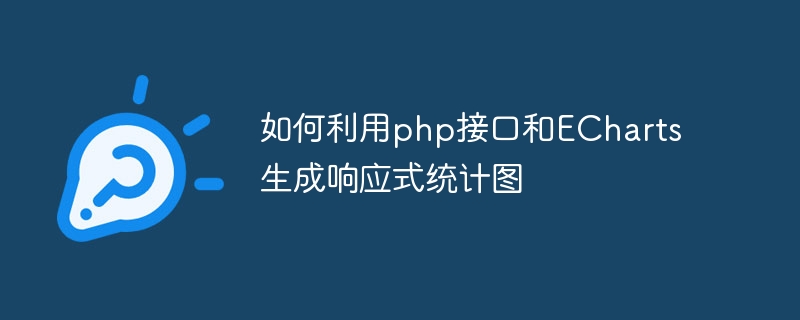

How to use PHP interface and ECharts to generate responsive statistical charts
With the continuous development of Internet technology, data analysis has become an indispensable part of our lives . Making some practical statistical charts is also an indispensable method in data analysis. In this article, we will introduce how to use the PHP interface and ECharts to generate responsive statistical charts, so that we can quickly create visual data analysis charts.
1. Environment setup
Before using PHP and ECharts to generate statistical charts, you need to set up some necessary environments. First, you need to install the PHP language environment and enable the GD library to support image generation. Secondly, you need to download the JavaScript library file of ECharts. It is recommended to download the latest version directly from the official website. Finally, install some commonly used open source PHP libraries, such as Predis, Guzzle and other libraries.
2. Data Acquisition
Before generating statistical charts, you need to obtain the data to be displayed and convert it into the required format. Here we take simple data acquisition as an example to introduce how to obtain data. First, you can use Guzzle to get data from external interfaces. Next, convert the obtained data into a PHP array through PHP's json_decode function. Finally, the data needs to be properly processed to make it comply with ECharts chart requirements. The following is a sample code for data acquisition:
use GuzzleHttpClient;
$client = new Client();
$res = $client->request('GET', 'http://xxx.com/api/data');
$data = json_decode($res->getBody()->getContents(), true);
// 对数据进行适当的处理,例如将数据转换为 ECharts 需要的格式
$echartsData = [];
foreach ($data as $item) {
$echartsData[] = [
'name' => $item['name'],
'value' => $item['value']
];
}3. Generate charts
After acquiring the data and processing the data appropriately, you can use ECharts to generate charts. First, you need to introduce the ECharts JavaScript library file into the HTML page. Then, by defining the necessary HTML elements and JavaScript code, the chart can be generated. The following is a sample code for generating a histogram:
<!DOCTYPE html>
<html lang="en">
<head>
<meta charset="UTF-8">
<title>柱状图</title>
<script src="echarts.min.js"></script>
</head>
<body>
<div id="main" style="width: 100%;height:400px;"></div>
<script>
var myChart = echarts.init(document.getElementById('main'));
var option = {
title: {
text: '柱状图',
left: 'center'
},
tooltip: {
trigger: 'axis'
},
xAxis: {
type: 'category',
data: ['数据项1', '数据项2', '数据项3', '数据项4'],
},
yAxis: {
type: 'value'
},
series: [
{
name: '数据量',
type: 'bar',
data: [10, 20, 30, 40],
itemStyle: {
normal: {
color: '#009688'
}
}
}
]
};
myChart.setOption(option);
</script>
</body>
</html>In the above code, we define an HTML element div#main to display the chart, and then specify the parameters of the chart through JavaScript code. Among them, echarts.init(document.getElementById('main')) is used to initialize the chart, and option specifies various parameters of the chart, such as chart title, value axis, legend, etc.
Finally, we can add the data processing results mentioned above to the corresponding chart parameters. For example, in the above code, we add the processed data to the series parameter to display the chart.
4. Responsive support
In order to ensure that the display effect of charts is consistent on different devices, responsive support for charts is required. Here we can use CSS and JavaScript to adjust the style and size of the chart. The following is a sample code for responsive support:
<!DOCTYPE html>
<html lang="en">
<head>
<meta charset="UTF-8">
<title>柱状图</title>
<script src="echarts.min.js"></script>
<style>
#main {
width: 100%;
height: 400px;
}
@media (max-width: 768px) {
#main {
height: 300px;
}
}
@media (max-width: 568px) {
#main {
height: 200px;
}
}
</style>
</head>
<body>
<div id="main"></div>
<script>
var myChart = echarts.init(document.getElementById('main'));
var option = {
title: {
text: '柱状图',
left: 'center'
},
tooltip: {
trigger: 'axis'
},
xAxis: {
type: 'category',
data: ['数据项1', '数据项2', '数据项3', '数据项4'],
},
yAxis: {
type: 'value'
},
series: [
{
name: '数据量',
type: 'bar',
data: [10, 20, 30, 40],
itemStyle: {
normal: {
color: '#009688'
}
}
}
]
};
myChart.setOption(option);
// 对图表进行响应式调整
window.onresize = function () {
myChart.resize();
};
</script>
</body>
</html>In the above code, we specify the style adjustment under different screen sizes through CSS @media, for example, when the screen width is less than 768px, Adjust the chart height to 300px. In addition, the chart is adaptively resized through the window.onresize event.
5. Summary
This article introduces the implementation process from data acquisition to chart generation by using the PHP interface and ECharts to generate responsive statistical charts. Through these code examples, I believe readers can master the use of ECharts, quickly generate beautiful statistical charts, and apply them to data analysis and display.
The above is the detailed content of How to use php interface and ECharts to generate responsive statistical charts. For more information, please follow other related articles on the PHP Chinese website!